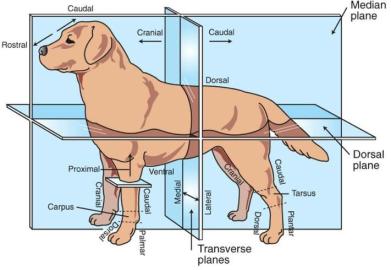
Lesson 2 Basic terminology
INTERNAL or INNER: Close to, or in the direction of, the center of an organ, body cavity, or structure.
EXTERNAL or OUTER: Away from the center of an organ or structure.
SUPERFICIAL: Relatively near the surface of the body or the surface of a solid organ.
DEEP: Relatively near the center of the body or the center of a solid organ.
PROXIMAL: Relatively near the main mass or origin; in the limbs and tail, the attached end.
DISTAL: Away from the main mass or origin; in the limbs and tail, the free end.
RADIAL: On that side of the forearm (antebrachium) in which the radius is located.
ULNAR: On that side of the forearm in which the ulna is located.
TIBIAL and FIBULAR: On the corresponding sides of the leg (crus), the tibial side being medial and the fibular side being lateral. In the dog and similar species, the paw is that part of the thoracic or pelvic limb distal to the radius and ulna or to the tibia and fibula. The human hand (manus) and foot (pes) are homologous with the forepaw and hindpaw, respectively.
PALMAR: The aspect of the forepaw on which the pads are located—the surface that contacts the ground in the standing animal—and the corresponding surface of the metacarpus and carpus.
PLANTAR: The aspect of the hindpaw on which the pads are located—the surface that contacts the ground in the standing animal—and the corresponding surface of the metatarsus and tarsus. The opposite surface of both forepaw and hindpaw is known as the dorsal surface.
AXIS: The central line of the body or any of its parts.
AXIAL, ABAXIAL: Of, pertaining to, or relative to the axis. In reference to the digits, the functional axis of the limb passes between the third and fourth digits. The axial surface of the digit faces the axis, and the abaxial surface faces away from the axis. The following terms apply to the various basicmovements of the parts of the body.


